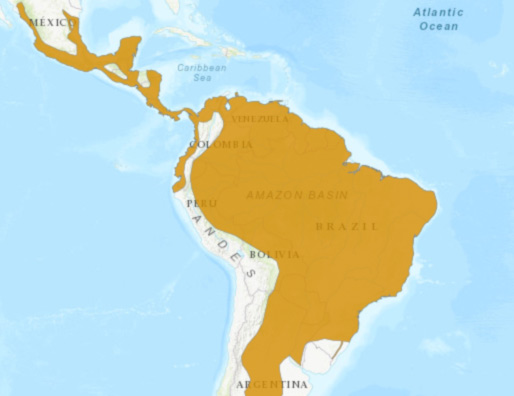Jaguarundi
Puma yagouaroundi
©Adriano Gambarini
Taxonomy
Standard English Name
Jaguarundi
Scientific Name
Puma yagouaroundi
Brazilian common name/s
Jaguarundi, Gato-mourisco, Gato-vermelho, Gato-preto
Conservation status - IUCN
Physical Description
This cat has a distinct appearance, with a slender and elongated body. The head is small and flat, with short, rounded ears, short legs and very long tail. Its coat has a uniform colour ranging from black or dark brown to reddish brown. Individuals with a darker colour are commonly associated with forests while generally individuals with lighter coats are found in drier areas.
Ecology and Habitat
Jaguarundis occur from the southern United States to central Argentina, and are found in various types of environments. Although one of the cats most commonly seen, it is not really abundant anywhere. It is extinct in Uruguay and is very rare in the south-western United States. These animals are diurnal and can be seen walking in pairs. They feed mainly on small mammals, reptiles and terrestrial birds, and may occasionally hunt animals of more than 1kg.
The gestation period ranges from 70 to 75 days, and females give birth to between 1 and 4 cubs.
Threats and Conservation
Habitat loss is the main threat to this species. In addition, little is known about the biology of this species, which limits the ability to generate effective conservation strategies.
Online links
IUCN redlist (http://www.iucnredlist.org) presents a synthesis of current knowledge about distribution and conservation status.
IUCN Cat Specialist Group: http://www.catsg.org/catsgportal/20_catsg-website/home/index_en.htm
IUCN Cat Specialist Group species accounts: http://www.catsg.org/catsgportal/cat-website/20_cat-website/home/index_en.htm
References
Caso, A., Lopez-Gonzalez, C., Payan, E., Eizirik, E., de Oliveira, T., Leite-Pitman, R., Kelly, M., & Valderrama, C. (2008). Puma yagouaroundi. In: IUCN 2010. IUCN Red List of Threatened Species. Version 2010.2. , , Downloaded on 04 July 2010.
Emmons, L. H., & Feer, F. (1997). Neotropical rainforest mammals: a field guide. Chicago: University of Chicago Press.
Michalski, F., & Peres, C. A. (2005). Anthropogenic determinants of primate and carnivore local extinctions in a fragmented forest landscape of southern Amazonia. Biological Conservation, 124, 383-396.
Michalski, F., Crawshaw, P. G., de Oliveira, T. G., & Fabian, M. E. (2006). Notes on home range and habitat use of three small carnivore species in a disturbed vegetation mosaic of southeastern Brazil. Mammalia, 70, 52-57.
Tofoli, C. F., Rohe, F., & Setz, E. Z. F. (2009). Jaguarundi (Puma yagouaroundi) (Geoffroy, 1803) (Carnivora, Felidae) food habits in a mosaic of Atlantic Rainforest and eucalypt plantations of southeastern Brazil. Brazilian Journal of Biology, 69, 873-877.
de Oliveira, T. G. (1998). Herpailurus yagouaroundi. Mammalian Species, 578, 1-6.
de Oliveira, T. G., Tortato, M. A., Silveira, L., Kasper, C. B., Mazim, F. D., Lucherini, M., Jácomo, A. T. A., Soares, J. B. G., Marques, R. V., & Sunquist, M. E. (2010). Ocelot ecology and its effect on the small-felid guild in the lowland Neotropics. In D. W. Macdonald & A. Loveridge (Eds.), Biology and Conservation of Wild Felids (pp. 563-584). Oxford: Oxford University Press.
